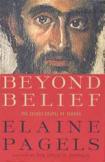Getting Past Orthodox Doctrine
There are Ph.D. dissertations yet to be written on religion according to Bill Moyers and the liberal intellectuals of Public Television. When they are, Professor Elaine Pagels of Princeton University will figure prominently as one of their well-known talking heads. Her earlier books, The Gnostic Gospels (1979) and The Origin of Satan (1995), are standard stock items in the big chain bookstores. This new book has been targeted at the same broad readership. It concludes with the same take-home message. What became orthodox or official Christianity repressed the diversity, individual freedom and spiritual innovation of true Christianity, exemplified in writings from members of ancient Gnostic sectsas well as other groups branded heretical.
Whatever the value of formal patterns of church authority, liturgy and teaching, in the end Pagels concludes that individuals are responsible for patching together a spirituality that uncovers and nurtures the divine within. She concludes: We have also seen the hazardseven terrible harmthat sometimes result from unquestioning acceptance of religious authority. Most of us sooner or later find out that, at critical points in our lives, we must strike out on our own to make a path where none exists. Though clearly indebted to elements of liberal Protestantism (without the social gospel ethic), Pagels’s conclusion will resonate with those American Catholics who feel betrayed by the official church.
Since Beyond Belief is religion lite for the PBS crowd, it would be unfair to debate Professor Pagels on scholarly details. Suffice to say that almost every generalization could be challenged or modified. Like any movie or documentary script, the catalogue of heroes and villains has been simplified beyond recognition. The author would have readers believe that these Gnostic writings had been hidden away in scholars’ file cabinets until she arrived at Harvard as a graduate student in the late 1960’s. While many of these writings were still unpublished, the major texts on which she based her subsequent scholarly careerHeracleon’s commentary on John, patristic accounts of Valentinians and Valentinian writings discovered in the mid-20th century, the Gospel of Truth, the Gospel of Philip and On the Resurrection, as well as the sayings collection the Gospel of Thomashad all been published in English. And they had been discussed at length in a popular book by the late Hans Jonas, The Gnostic Religion (1958). The latter is still one of the finest efforts at delineating the spirit of Gnostic writings that we possess. As Jonas might observe, there is a gnosticizing trend toward nihilism in modern intellectual circles. The intellectual as hero must be self-generated (Greek: autogenesa fine Gnostic term for the Son in the divine triad of Father, Mother and Son).
Professor Pagels divides her tale of Christianity from its origins to Constantine into five chapters devoted to related topics in the eventual triumph of orthodoxy. The first chapter advocates divorcing oneself from the fourth-century conclusion that candidates for baptism and Communion must profess belief in a set of complicated doctrines (a creed). Hence the words of the book’s title, beyond belief, mean getting beyond a Christianity of orthodox doctrine. Pagels grounds her case on the origins of Christianity as private, household-based cultic associations more interested in the miraculous and personal experiences of transformation than a system of doctrines.
Chapter Two is built on an interpretation of John’s Gospel and the Gnostic version of a collection of Jesus’ sayings known as the Gospel of Thomas advocated by a group of scholars associated with Helmut Koester at Harvard University. According to this school, the Johannine discourses are developments from a tradition opposed to Thomas and the kind of revelatory sayings and initiation tradition that are preserved in Gnostic sources. These scholars assume that the Gospel of Thomas reflects a mid-first century work with an elaborate theory of origins, exegesis of Genesis, soteriology and mystical doctrine. Those of us who have not been persuaded by any of the scholarly articles advancing these views will hardly accept Pagels’s assertion that John’s Prologue was composed to reject Thomas’ claim that we have direct access to God through the divine image within us, even though John does insist that Jesus is the sole mediator of revelation about God. Butand Pagels knows thisGnostic authors agree that descent of a heavenly revealer is required to mediate our discovery of the true self.
Chapters Three and Four are devoted to the question posed at the end of the second chapter. How did John’s Gospel come to prevail as the standard for Christian orthodoxy? Tertullian and Irenaeus serve as the central figures in advocating a vision of unity that excluded much of the rich diversity found among second-century Christians. Revelations, religious experiences or teaching that do not conform to the four-Gospel canon and the apostolic tradition are to be rejected. Readers may find these chapters somewhat confusing as the author jumps between various movements reported in the writings against heresies, martyrdom accounts, assorted Gnostic texts and the apocryphal Acts of John. Although the final chapter is titled Constantine and the Catholic Church, its first half continues to describe Irenaeus’s opposition to the religious visions of his Gnostic opponents. The period between the late second century and the early fourth has been omitted entirely. Yet, as Professor Pagels knows, some Gnostics appear to have moved away from Christianity to seek common cause with Neo-Platonic mysticism. Their books were known in the school of Plotinus in mid-third-century Rome.
Students of early Christian history should look to some of the articles and books mentioned in the footnotes for better analyses of the topics mentioned. General readers may have trouble sorting out the unfamiliar names, movements and texts in the middle chapters. But the overall message will find a sympathetic ear among those seeking an alternate story of Christian origins.
This article also appeared in print, under the headline “Getting Past Orthodox Doctrine,” in the July 7, 2003, issue.








